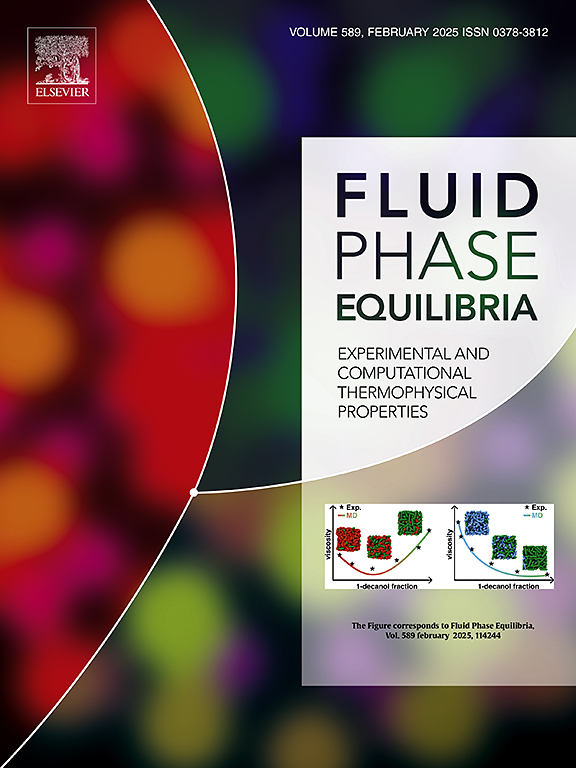利用人工神经网络预测三酰甘油的熔化和固相转变温度和热焓
IF 2.8
3区 工程技术
Q3 CHEMISTRY, PHYSICAL
引用次数: 0
摘要
三酰甘油(TAG)是植物油的主要成分,任何模拟植物油过程的尝试都需要了解其特性。然而,由于一些纯 TAG 无法获得或过于昂贵,无法进行实验测量,因此实验值非常稀少。另一方面,将物理性质与 TAG 分子结构联系起来并不简单。TAG 是由 3 个脂肪酸(FA)酯化到甘油(GL)骨架上组成的分子,其特性取决于每个 FA 的碳数(CN)、每个 FA 的不饱和数(UN)以及 FA 在 GL 骨架中的位置。文献中用于预测 TAG 熔化特性的模型很少,其中特别关注 TAG 多形态的熔化温度(Tfus)和熔化焓(ΔHfus)以及固-固转变特性。Wesdorp 的著作、Moorthy 等人的著作以及 Zeberg-Mikkelsen 和 Stenby 的著作提出了基于目前使用的基团贡献理论的模型,尽管这些模型存在一些缺陷,特别是在考虑多晶型转变时。因此,这项工作旨在评估人工神经网络(ANN)模型,以预测 TAG 的 Tfus 和 ΔHfus(β-form),以及分子多晶型(α 和 β')的温度和焓变。数据库由文献中的温度和焓实验数据组成。为每种 TAG 提供了 7 个输入数据:总的 CN 以及 TAG Sn-1、2 和 3 位置上的 CN 和 UN。采用多层感知器前馈(MPL)模型,并对拓扑结构的隐层数(HL)、神经元数(NN)和每个隐层的激活函数以及收敛算法进行了评估。采用中央复合可旋转设计(CCRD)筛选 HL 和 NN 的数量。通过可解释人工智能(XAI)和特征评估策略对模型进行了进一步评估。在计算和预测 TAG 的 3 种多态形式的熔化特性时,体系结构显示出明显更高的准确性,与文献模型相比,所有数据库的 R2 均高于 0.91(β 形式的熔化温度预测除外,尽管非常相似,但 Wesdorp 的模型显示出更好的预测能力)。良好的结果可能与输入(分子结构描述符)和输出(熔化特性)之间明确的物理化学关系有关,这种关系可以通过 XAI 评估来描述。考虑到改进包括 TAG 分子在内的工艺和产品设计的性能,这是一个重要的优势。本文章由计算机程序翻译,如有差异,请以英文原文为准。
Prediction of melting and solid phase transitions temperatures and enthalpies for triacylglycerols using artificial neural networks
Triacylglycerols (TAG) are the main components of vegetable oils and any attempt to simulate vegetable oils processes will demand knowledge of their properties. However, experimental values are scarce, considering that several TAG in their pure forms are unavailable or too expensive for experimental measurements. On the other hand, correlating physical properties with TAG molecular structure is not simple. TAG is a molecule composed of 3 fatty acids (FA) esterified to a glycerol (GL) backbone, making properties dependent on carbon number (CN) of each FA, number of unsaturations (UN) of each FA, and position of the FA in the GL backbone. Few models are available in literature for prediction of TAG melting properties, with a special attention to melting temperature (Tfus) and enthalpy (ΔHfus) and solid-solid transition properties of the TAG polymorphic forms. Wesdorp's, Moorthy's et al. and Zeberg-Mikkelsen and Stenby's works present models based on the Group-Contribution theory nowadays used, despite some flaws, particularly considering the polymorphic transitions. Therefore, this work was aimed at evaluating Artificial Neural Network (ANN) models for prediction of TAG's Tfus and ΔHfus (β-form) as well as temperature and enthalpy transitions of molecule polymorphic forms (α and β’). Database was composed of temperature and enthalpy experimental data from literature. For each TAG, 7 input data were provided: total CN, as well as CN and UN at sn-1, 2 and 3 TAG position. The Multilayer Perceptron Feed Forward (MPL) model was used, and the topology was evaluated for number of hidden layers (HL), number of neurons (NN) and activation function at each hidden layer, and convergence algorithm. Number of HL and NN was screened by using a Central Composite Rotatable Design (CCRD). Models were further evaluated by Explainable Artificial Intelligence (XAI) and feature evaluation strategies. Architectures showed a significant higher accuracy for calculation and prediction of TAG's melting properties of the 3 polymorphic forms, with R2 higher to 0.91 for all databases when compared to literatures’ models (excepted for the prediction of the melting temperature of the β form, where Wesdorp's model presented a better predictive ability, despite great similarity). Good results were probably related to the well-defined physicochemical relationship between input (molecular structure descriptors) and output (melting properties), that could be described by XAI evaluation. This is an important advantage considering the improvement of the performance of process and products design including TAG molecules.
求助全文
通过发布文献求助,成功后即可免费获取论文全文。
去求助
来源期刊

Fluid Phase Equilibria
工程技术-工程:化工
CiteScore
5.30
自引率
15.40%
发文量
223
审稿时长
53 days
期刊介绍:
Fluid Phase Equilibria publishes high-quality papers dealing with experimental, theoretical, and applied research related to equilibrium and transport properties of fluids, solids, and interfaces. Subjects of interest include physical/phase and chemical equilibria; equilibrium and nonequilibrium thermophysical properties; fundamental thermodynamic relations; and stability. The systems central to the journal include pure substances and mixtures of organic and inorganic materials, including polymers, biochemicals, and surfactants with sufficient characterization of composition and purity for the results to be reproduced. Alloys are of interest only when thermodynamic studies are included, purely material studies will not be considered. In all cases, authors are expected to provide physical or chemical interpretations of the results.
Experimental research can include measurements under all conditions of temperature, pressure, and composition, including critical and supercritical. Measurements are to be associated with systems and conditions of fundamental or applied interest, and may not be only a collection of routine data, such as physical property or solubility measurements at limited pressures and temperatures close to ambient, or surfactant studies focussed strictly on micellisation or micelle structure. Papers reporting common data must be accompanied by new physical insights and/or contemporary or new theory or techniques.
 求助内容:
求助内容: 应助结果提醒方式:
应助结果提醒方式:


